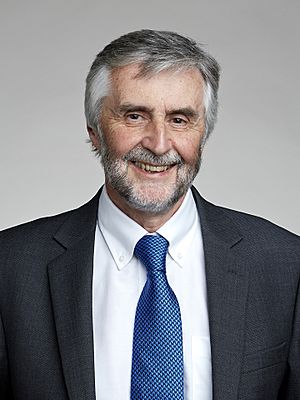Patrick Gill (physicist) facts for kids
Quick facts for kids
Patrick Gill
|
|
|---|---|

Gill in 2016
|
|
| Alma mater |
|
| Employer |
|
| Awards |
|
| Website | www |
| Scientific career | |
| Thesis | Charge Transfer as a Laser Excitation Mechanism (1975) |
| Doctoral advisor | Colin Webb |
Patrick Gill is a British physicist who works at the National Physical Laboratory (NPL) in the UK. He is a Senior NPL Fellow in Time & Frequency. This means he is a top expert in how we measure time and frequency very, very accurately.
Contents
Education and Early Research
Patrick Gill studied at the University of Sussex and the University of Oxford. In 1975, he earned his PhD degree from Oxford. His research was about how lasers work by moving energy between atoms. This is called "Charge Transfer as a Laser Excitation Mechanism."
Amazing Atomic Clocks
Gill's main work is about making super accurate clocks. These are not like the clocks on your wall! They are called atomic clocks. He uses special lasers to make these clocks incredibly precise.
How Atomic Clocks Work
Atomic clocks use the natural vibrations of atoms to keep time. Imagine an atom as a tiny, perfect pendulum that swings billions of times a second. Gill's research helps make these "swings" even more stable and measurable.
Future of Time Measurement
His work helps develop the next generation of optical atomic clocks. These clocks are so accurate that they could change how we define the "second." The "second" is a basic unit of time in science. His clocks are even more precise than the current best time standards, like the caesium fountain clocks.
Holding Atoms Still
To make these clocks work, scientists need to hold tiny particles very still. Gill uses special methods for this:
- He uses lasers to cool down single ions (atoms with an electric charge). These ions are then held in "radiofrequency traps." Think of these as invisible cages made of electric fields.
- He also uses "optical lattices" to hold neutral atoms. These are like tiny nets made of light.
Lasers for Everyday Life
Besides clocks, Patrick Gill has also developed very stable lasers. These lasers are used in many important areas:
- Precision Engineering: Making things with extreme accuracy, like parts for advanced machines.
- Space Science: Helping with missions to space.
- Satellite Navigation: Improving systems like GPS that help you find your way.
- Earth Observation: Studying our planet from space.
- Optical Telecommunications: Making sure internet and phone signals travel fast and clearly through fiber optic cables.
Awards and Recognition
Patrick Gill has received many important awards for his scientific work:
- In 2007, he received the I. I. Rabi Award. This award recognized his contributions to measuring time and frequency. It also honored his work on single ion optical frequency standards.
- In 2008, he was given the Young Medal and Prize. This was for his world-leading work in measuring optical frequencies.
- In 2014, his team received the Duke of Edinburgh Award from the Royal Institute of Navigation. This award was for their long-term work on atomic clocks.
- In 2015, he was awarded an MBE by The Queen. This honor was for his great service to science.
- In 2016, he was elected a Fellow of the Royal Society (FRS). Being a Fellow of the Royal Society is a very high honor for scientists in the UK.
Patrick Gill is also a visiting professor at Imperial College London and the University of Oxford.

